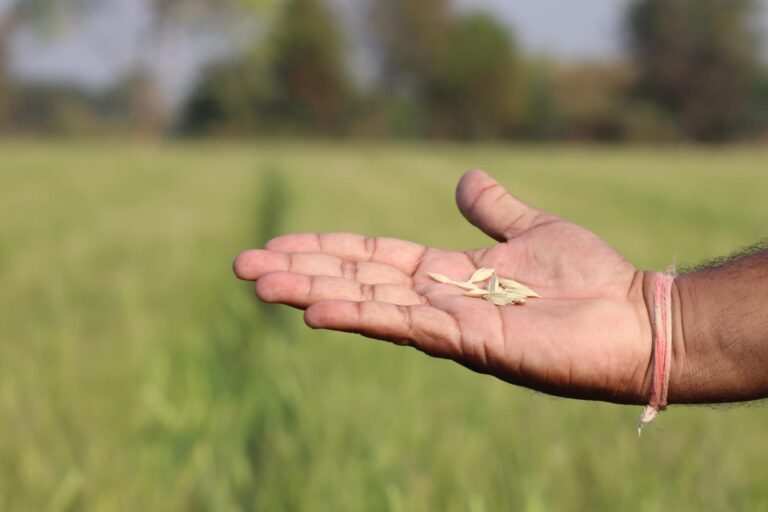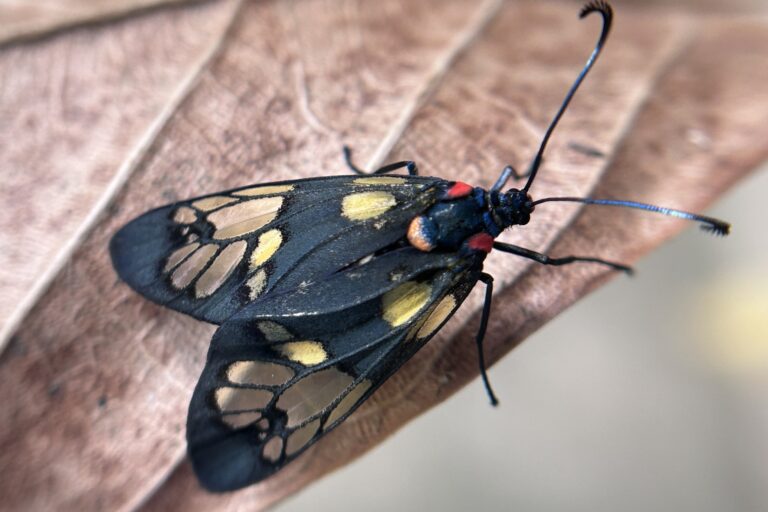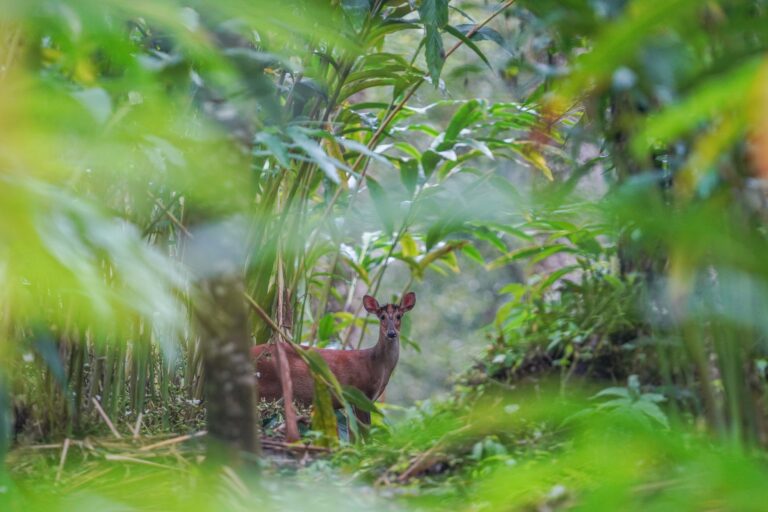- Woodpecker species in the sub-Himalayan sal forests segregate their foraging based on the size of the trees, height and part of the tree on which they forage and level in the canopy.
- Large woodpeckers foraged on larger trees while small species perched on smaller trees. But all woodpeckers, regardless of their size, prefer to forage on larger trees available in their habitat.
- Removal of large trees could affect the abundance of large-sized species such as the Great Slaty Woodpecker, the largest surviving woodpecker species.
- Foraging woodpeckers also use dead trees, which play a role in supporting woodpecker communities. Experts suggest retaining standing dead trees in managed forest stands—at least those in woodpecker habitats.
Different species of woodpeckers living in the sal forests of the sub-Himalayan foothills of northwestern India show distinct foraging preferences – they forage depending on the size of the tree, the height and part of the tree on which they forage and their position in the canopy, finds a recent study. These foraging patterns are one of the mechanisms by which the different woodpecker species coexist. Larger trees in the forest were found to be important not only for large woodpeckers but for all species.
“When trees are felled, one tends to forget that those are maybe hundreds of years old,” said lead author Raman Kumar, director and research associate of Dehradun-based non-profit Nature Science Initiative. “Although there is a provision for compensatory plantation when you fell a large tree,” explained Kumar, “even if you plant ten small trees, it can never be an ecological compensation because the features and ecosystem surrounding the large trees have taken maybe hundreds of years to stabilise.”
The study was conducted in the tropical moist deciduous forests in the state of Uttarakhand, which are dominated by sal (Shorea robusta), a native species that was highly sought-after at the end of the nineteenth century because its timber was used for the railway sleepers on which the tracks were laid. It is a very slow-growing tree, Kumar pointed out, stating that “a tree of a diameter of say a couple of feet would easily be perhaps 150-200 years old.”
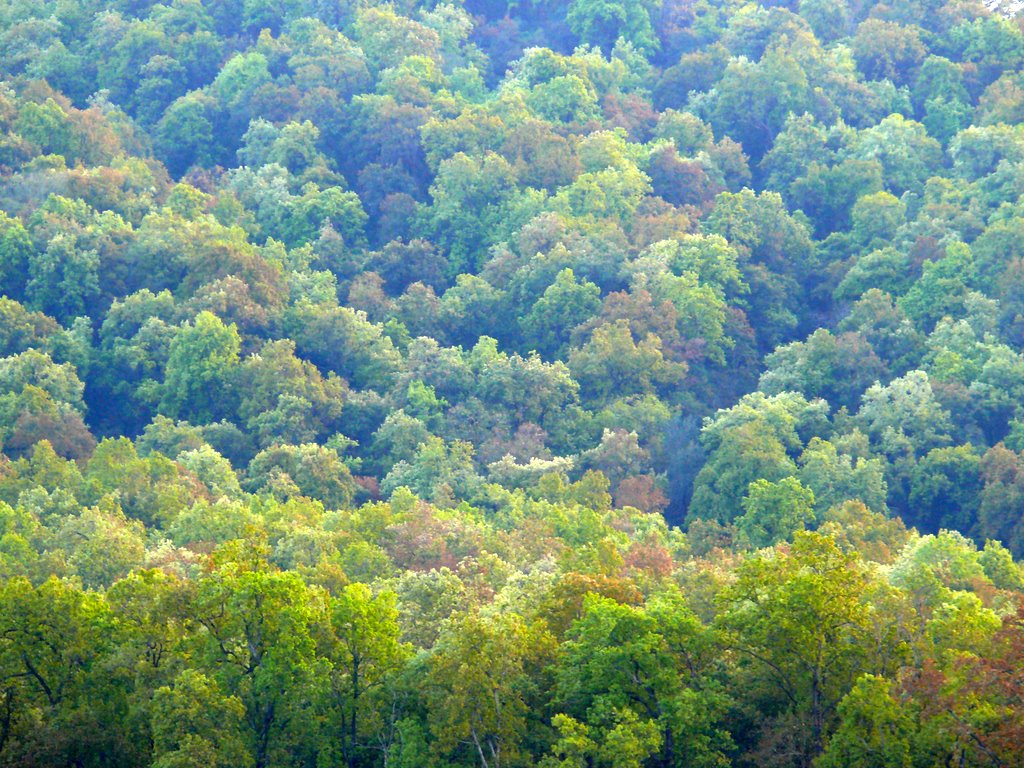
Prior to the 1980s, intensive management included harvesting of live trees beyond a predetermined threshold size and was practiced by rotation in forest stands (called ‘compartments’), said Kumar. But post-1980, there was a shift in forest management in the region and active intervention was limited to removing dead trees, explained Kumar. But, he added, “since the natural structure of the forest has been modified earlier by management officials and considering that it is a very slow-growing species, the effects still linger on and they tend to affect the woodpecker community here.”
Do woodpeckers show differences in their choice of foraging locations and substrates (trunk or branches) and does the size of the species play a role? To find out, they conducted field surveys at eight sites at Corbett Tiger Reserve and Ramnagar Forest Division, which support 17 woodpecker species. Upon sighting a woodpecker, they noted the diameter of the foraging tree, height at which the bird was found on the tree, the part of the tree on which the bird was foraging such as the trunk or type of branch and its vertical position in the tree canopy.
“The sub-Himalayan region is world-famous for having the highest diversity of woodpeckers,” said avian evolutionary ecologist Sahas Barve who is a Fellow at the Smithsonian National Museum of Natural History and was not involved in the study. He noted that the study shows that “if you want to conserve the entire gamut of woodpecker diversity, we need to conserve the entire forest.”

Size of trees chosen for foraging mirrors woodpecker body size
According to the study, the ten woodpecker species observed likely coexist in the region by selectively foraging on trees of different sizes and at different heights and parts of the tree. If two species overlap along one dimension such as foraging on similar-sized trees, they would generally segregate in other dimensions such as occupying different levels of the canopy or parts of the tree.
The size of the trees the woodpeckers foraged on was associated with the bodyweight of the species. Smaller-sized species chose smaller trees for foraging while larger woodpeckers perched on larger trees. “It’s very difficult for a larger bird to perch on smaller substrates and smaller-sized trees. So the larger birds naturally tend to forage on larger trees because they are limited by the minimum size on which they can perch,” explained Kumar.
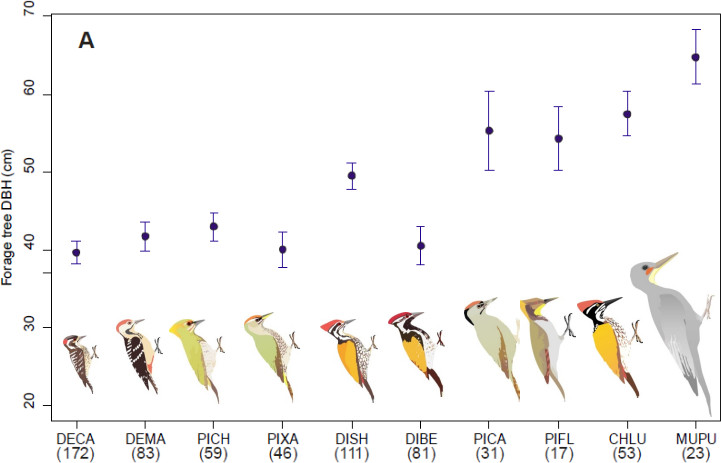
But, regardless of their size, all woodpeckers prefer to forage on larger trees available in their habitat. “It is simple economics because of the efforts and returns: the time it spends searching on larger trees is worth its while in terms of the food it obtains,” Kumar explained. “Larger trees would have a lot more forage available. So, for example, if a bird feeds on a tree which is 6 inches in diameter, it has a lot more surface area than a tree which is say 4 inches in diameter. Suppose a woodpecker spends 10 minutes foraging on a thicker tree, it would be able to scan a larger surface area and so obtain more food for the same effort.”
Removal of large trees could affect the abundance of large woodpeckers, the findings suggest. In an earlier study assessing how habitat variables affect the abundance and richness of woodpecker species in the region, the authors found that large trees could be crucial for conserving native woodpecker communities.
Great slaty woodpecker, listed as ‘vulnerable’ in the IUCN Red List of Threatened Species, is the largest surviving woodpecker species and is naturally distributed in broadleaved forests in northwest India down to Southeast Asia. It feeds on large, old trees and its population has shrunk by almost 90 percent over the past few decades due to deforestation.

Since great slaty woodpeckers are large, crow-sized birds, “they need a very big cavity and you can’t have a big cavity in a small tree so you need big dead trees or at least big trees in the forest to have a healthy population of Great Slaty Woodpeckers,” said Barve.
If a forest only had small trees there would still be woodpeckers, said Barve, but he warns that large woodpeckers such as the great slaty could be wiped out. “A forest with big trees will ensure that multiple species of woodpeckers can live together.”
The value of dead trees
While standing dead trees were used by all of the species studied, the large-sized greater flameback woodpecker showed a notable preference for dead trees. Because dead trees are often considered fire hazards, they are the first to be removed from a forest, explained Kumar. But even though the number of dead trees is smaller in proportion to the total number of trees in the forest, they could play a critical role, he noted, adding that more research is needed. Barve, who has studied the ecology of birds in the Himalayas, also pointed out that dead trees and snags harbour a lot of species.
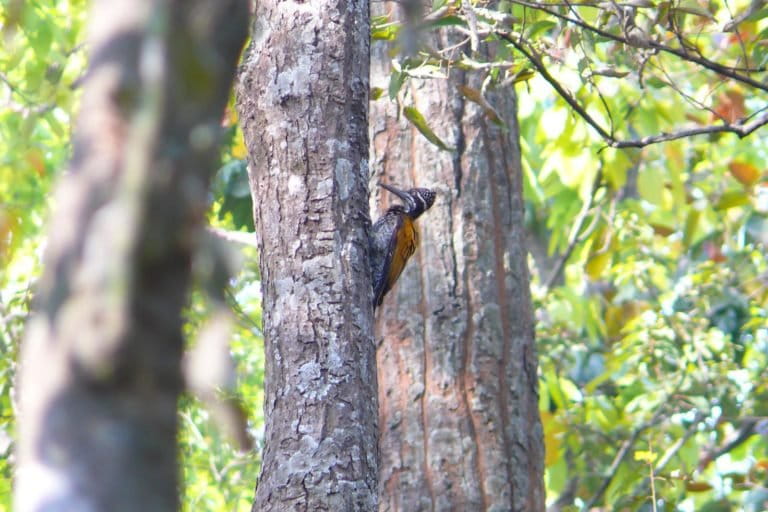
Woodpeckers are one of the few ‘primary cavity nesters,’ explained Barve, which means that they excavate or build new cavities in the forest and these cavities are then used by a slew of flycatchers, warblers and other birds for nesting. “Generally speaking, dead trees are easier to make cavities and they often make cavities in dead trees, but it’s not the only limiting thing and they will use live trees if there are no dead trees at hand.”
Kumar suggests retaining standing dead trees in forests and especially in compartments that are known woodpecker habitats. Barve agrees, stating that dead trees should be left alone because they probably keep standing for years and apart from habouring insects that break down the wood, which eventually become food for birds, they are also used for nesting.
“Just because a tree is dead, it doesn’t mean it has lost its value to nature,” stressed Barve.
CITATION:
Kumar, R., Shahabuddin, G., & Kumar, A. (2020). Foraging niche differentiation among sympatric woodpecker species in forests of north-western India. Acta Ornithologica, 55(1), 88-100.









